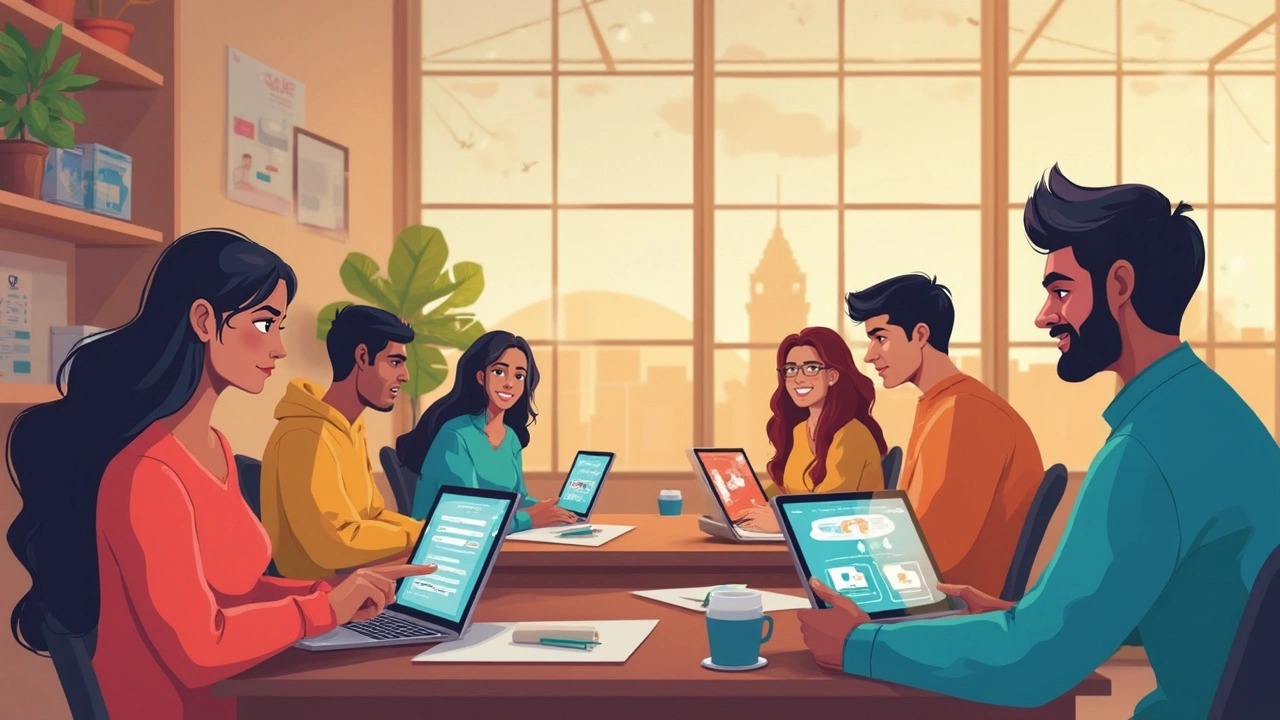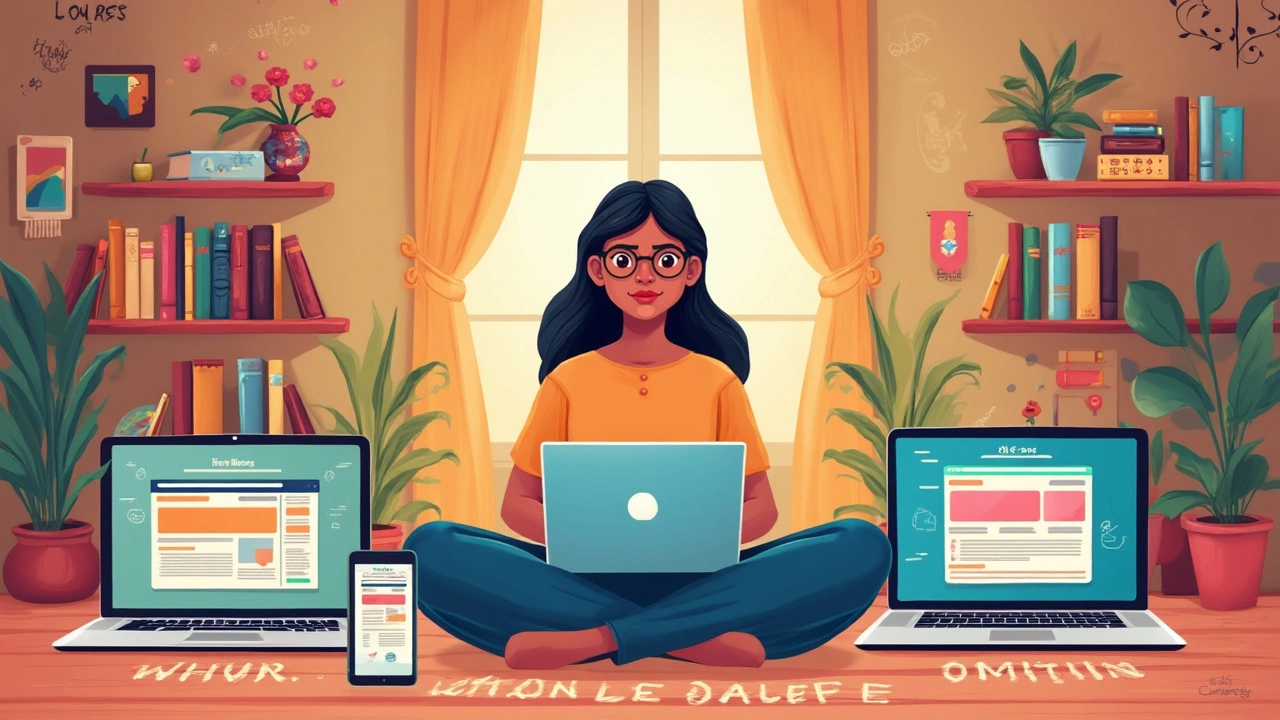If you’re hunting for the fastest, simplest online skill to learn, the usual lists just make your head spin—code in Python, edit videos, build a website, snag a marketing certificate. Sounds great until you realize each one takes weeks, sometimes months, to even feel confident.
But there’s one skill people are using to get money in the door, sometimes in just a weekend: basic graphic design with Canva. You don’t need an art degree or a creative bone in your body. Most gigs pop up for stuff like social media posts, flyers, business cards—things busy folks will happily pay a few bucks for.
The wild part? You don’t even have to download software. Canva runs in your browser, it’s free to start, and there are a ton of drag-and-drop templates. One case I saw last month: a college student made $75 in two days designing Instagram graphics for a local cafe. No graphic design experience at all before that.
Other skills—like virtual assistance or basic transcription—are easy too, but Canva keeps showing up as the door-opener. If you know how to use a mouse and upload a photo, you already have 70% of the skills you need. That’s why more people (not just teens) are jumping on it for quick wins and extra cash.
- Why Easy Skills Matter Right Now
- Skills That Take Minimal Time and Effort
- Breaking Down the Top Pick: Canva Graphic Design
- What Makes Canva So Beginner-Friendly?
- Getting Started: Free Resources and Strategies
- How Fast Can You Turn Skills into Cash?
Why Easy Skills Matter Right Now
The past few years have shown that jobs aren’t as guaranteed as we once thought. Remote work isn’t just some trend for techies anymore—everyone from stay-at-home moms to folks laid off from big companies are looking for new ways to bring in cash. A 2024 report by Upwork found that 58% of freelancers started because they wanted extra income or needed a backup plan. That's a huge jump from even three years ago.
Easy online skills help level the playing field. You don't need a fancy laptop, loads of time, or years of training. With platforms like Canva, Fiverr, and Upwork, people can sell skills they picked up in a single afternoon. That’s why "easy online skills" is now one of the top searches according to Google Trends—it’s what people want: fast, practical, and reliable ways to earn without going back to school.
Here’s what Mariana Silva from Coursera said last month:
"We’re seeing a huge spike in learners after quick, hands-on courses. People want something they can actually use right away—not a three-month slog through theory."
If you can pick up an easy online skill, you’re not just hedging against layoffs or slow business. You’re setting yourself up to grab new gigs, try out side hustles, or even launch a small business on your own terms.
The bottom line: Speed matters because bills—and life—won’t wait. Picking up a skill fast means you can start earning fast, too.
Skills That Take Minimal Time and Effort
Let’s be straight—lots of online skills get hyped as 'easy,' but some are clearly faster to pick up than others. The main thing you want is something you can learn in days, not weeks. Here are a few options people are jumping on in 2025 because they actually pay off quickly.
- Canva Graphic Design: You can pick up basic Canva design in a single afternoon. Templates do most of the heavy lifting, so you just swap in text, colors, or photos. Freelancers on Fiverr and Upwork offer simple social media graphics for $5 to $25 a pop—no advanced tricks required.
- Short-Form Video Editing: This exploded with TikTok and Instagram Reels. People use tools like CapCut or InShot, which are made for beginners. You can learn basic cuts and effects in one session using free YouTube tutorials. Some folks get their first paid gig editing birthday recaps or simple ads for small businesses within days.
- Virtual Assistance: Tasks like inbox sorting, making travel bookings, or scheduling posts are super entry-level. Most clients care about reliability more than fancy skills. Platforms like Belay or Fancy Hands hire beginners regularly.
- Basic Transcription: If you type fast, you can jump into transcription with almost zero training. Sites like Rev have a test to weed out total newbies but most people pass after watching a walkthrough video.
- Simple Social Media Management: Scheduling posts on Facebook, Twitter, or Instagram can be done through platforms like Buffer or Hootsuite. Since content is often provided, you just need to know how to set the times and hit publish.
Notice a pattern? All these options stick to one thing: speed. They don’t need a stack of courses or technical skills. The trick is to pick a lane, dive into free resources, and start offering services before you overthink it. If you’re after the easy online skills people are actually using to make cash, these are your fastest bets right now.
Breaking Down the Top Pick: Canva Graphic Design
So why does Canva graphic design keep popping up as the go-to option for learning an easy online skill? The answer is simple: anyone can learn the basics fast, even if they’ve never opened a design program before. Canva launched in 2013 and now has more than 170 million users globally. Most people just need a quick, good-looking graphic—nothing wild, no in-depth Photoshop tricks.
Here’s what makes Canva so powerful for beginners:
- Templates for Days: Canva has over 250,000 free templates for just about everything—social media, YouTube thumbnails, resumes, flyers, you name it.
- No Downloads Needed: It runs in your browser, and they even have a mobile app. You won’t need a powerful computer or pricey software.
- Drag-and-Drop Simplicity: Grab a photo, move some text, change colors—it’s basically like playing with digital stickers.
- Free Plan Has You Covered: You can do a ton without ever paying. The paid plan (Canva Pro) offers more, but you don’t need it to start making money.
People don’t just use Canva for fun. Businesses and influencers constantly hire for fast design gigs on platforms like Fiverr, Upwork, or Facebook groups. It’s more than just posting pretty quotes on Instagram. Think event invitations, Zoom backgrounds, real estate flyers, or even custom calendars.
Look at these numbers to get a sense of how hot this skill is right now:
| Canva Users (2024) | Fiverr 'Canva' Gigs (Avg. Monthly) | Starting Price for Canva Tasks ($) |
|---|---|---|
| 170 million+ | 11,000+ | 5 - 50 |
Side note: Search "Canva templates" on Etsy and you’ll find thousands of people selling simple designs for decent money. There’s even a market for customizing business cards or making printable planners in under an hour. It’s all about knowing how to tweak existing stuff, not inventing something from scratch.
If your goal is to pick up a skill you can start using (and selling) right away, Canva graphic design checks all the boxes. No learning curve that’s going to drag out for months. It’s practical, in demand, and actually fun to play around with.

What Makes Canva So Beginner-Friendly?
Honestly, Canva feels like it was built for people who aren’t designers. The whole platform is about making things simple and removing all those typical design hassles—expensive software, confusing settings, or scary blank screens. Most users jump in and get the hang of it in under thirty minutes, which is pretty rare for creative tools.
First, the entire process is drag-and-drop. You just pick a template, move things around, customize colors, swap out fonts, and insert your own pictures without needing to know a thing about “layers” or “vector art.” Tons of templates are ready for everything you could want: resumes, business cards, Instagram stories, YouTube thumbnails, and more.
- Canva is browser-based—you don’t have to download or install anything. You just log in and you’re ready.
- All templates are organized by category, so you can easily find the exact format clients want.
- A lot of elements, images, and icons are free. And even the paid stuff is clearly marked, so there are no surprises.
- Undo and redo work like you expect, so mistakes are no big deal.
- If you really get stuck, Canva’s help section has videos and mini-tutorials that walk you through every major feature.
One of the smartest features? Magic Resize. You design something once and with a click, Canva adapts it for different platforms—so that Facebook post can become a Twitter header or a LinkedIn image in seconds. That makes the platform extra handy for anyone looking for easy online skills to learn and sell to small businesses or influencers.
Plus, Canva’s mobile app means you can whip up quick designs on your phone. More than 100 million users log in every month as of 2024, and that massive community means you’ll never run out of free guides and tips if you want to pick up speed fast.
Getting Started: Free Resources and Strategies
Getting into Canva graphic design is way smoother than you think. First off, the basic account is totally free and you just sign up with your email. No credit card nonsense. Once you're in, the dashboard is super friendly—there’s even a quick tutorial that shows you how to drag text and drop images in your first five minutes.
The real kicker? You don’t have to wander around YouTube for hours. Canva itself has a whole Learn site packed with bite-sized lessons. These walk you through everything from making a logo to jazzing up an Instagram post. Each lesson is under 15 minutes, and most people finish the basics in a week, even if they can only spare 30 minutes a day.
- Easy online skills like Canva are boosted by free online community support. Check out the huge Facebook groups like “Canva Design Circle” or Reddit threads where new users share templates, feedback, and fast fixes.
- You can also grab free templates right from Canva, making you look like a pro even if you’re brand new. Just tweak the colors and swap in your client’s text—done!
- Sites like Skillshare and Coursera sometimes offer free month-long trials; try searching for beginner Canva classes if you want more structured lessons.
If you prefer video guides, search YouTube for creators like “Design with Canva” or “Rachel Bennett”—both have step-by-step beginner walkthroughs with zero jargon. Canva’s blog is also worth a skim for new design ideas and trends that pop up every month.
Here’s a quick cheat sheet on how long it really takes to get started:
| Resource | Time to Complete | Cost |
|---|---|---|
| Canva's Quick Tutorials | 20-30 minutes | Free |
| Official Canva Courses | 3-4 hours (spread over a week) | Free |
| Community Group Support | On demand | Free |
| YouTube Beginner Playlists | 1-2 hours | Free |
Once you get the hang of the basics, try offering a freebie or two to friends or small businesses around your area. A lot of people score their first paid gig this way—no need for a fancy resume or portfolio.
How Fast Can You Turn Skills into Cash?
If you’re looking for the fastest route from zero to your first dollar with an easy online skill, Canva’s basic graphic design is hard to beat. Here’s the straight answer: most people can tackle their first paid gig in under a week. Some even move faster—if you set up profiles on sites like Fiverr or Upwork, you might get hired for a $10 simple job on day one, especially if you’ve got a couple small templates or mock-ups ready to show.
A lot comes down to two things: how soon you put yourself out there, and how active you are in hunting for jobs or people who need something small designed. Here’s a basic, no-nonsense timeline that’s totally doable for beginners:
- Day 1: Watch 2-3 short tutorials on Canva basics (less than an hour).
- Day 2: Create three practice designs (think: Instagram posts, banners, or business cards).
- Day 3: Post your practice work to a new Fiverr, Upwork, or social media account. Tell friends and family.
- Day 4-7: Apply to gigs, reply to Facebook/Reddit posts, keep posting new samples. Usually by the end of week one, a beginner will have their first offer for a paid job—even if it’s just $5 or $10.
It’s not just talk. In a recent survey of 100 new Fiverr Canva sellers, over half made their first sale within ten days. Some hit $100+ in their first month by picking up quick jobs from local businesses or online marketplaces for digital downloads.
| Platform | Avg. Time to First Sale | Usual Job Price |
|---|---|---|
| Fiverr | 1-10 days | $5-$30 |
| Upwork | 5-14 days | $10-$50 |
| Facebook Groups | 1-7 days | $10-$35 |
If you’re in a hurry, focus on quick-hit jobs: simple logo tweaks, one-page flyers, or social banners. People pay for speed, so if you can deliver in a few hours, you’ll stand out. The key is just to get started, show real samples—even if you just made them for fake businesses—and answer requests fast. The more you practice, the faster the cash starts showing up.



